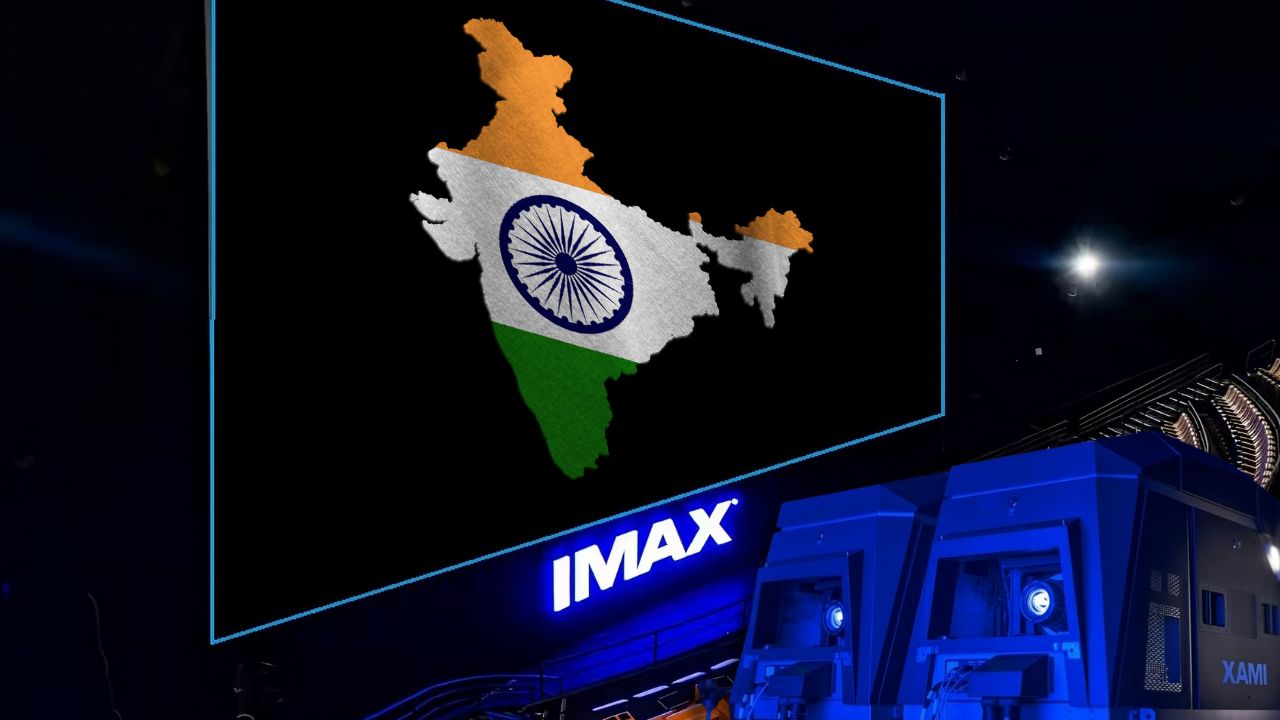Last updated on 19 December 2025.
IMAX had a slow start in India, but now it’s picking up the pace. Many cinephiles around the world believe it is the only way a movie should be seen on the big screen.
The journey of IMAX in India began in the early 2000s, and today, they are popping all over the country.
Let’s find out how all of this started, where you can find them, and which is the best in your city?
Complete List of IMAX Theatres in India
There are 35 IMAX screens in India. Here is the complete list:
| No | Cinema Name | City |
|---|---|---|
| 1 | PVR Select City Walk (Saket) | Delhi |
| 2 | PVR Priya (Vasant Vihar) | Delhi |
| 3 | PVR Vegas Mall (Dwarka) | Delhi |
| 4 | INOX Vishal Mall (Rajouri Garden) | Delhi |
| 5 | INOX Paras (Nehru Place) | Delhi |
| 6 | PVR Superplex Logix (Sector 32) | Noida |
| 7 | PVR Superplex, Mall of India (Sector 18) | Noida |
| 8 | PVR Ambience Mall (Sector 24) | Gurugram |
| 9 | Miraj Cinemas (Wadala) | Mumbai |
| 10 | PVR ICON Phoenix Palladium (Lower Parel) | Mumbai |
| 11 | INOX Sky City Mall (Borivali) | Mumbai |
| 12 | INOX R City Mall (Ghatkopar) | Mumbai |
| 13 | EROS INOX (Churchgate) | Mumbai |
| 14 | INOX Maison, Jio World Plaza (BKC) | Mumbai |
| 15 | INOX Megaplex Inorbit Mall (Malad) | Mumbai |
| 16 | Cinepolis Nexus Seawoods (Nerul) | Navi Mumbai |
| 17 | Cinepolis Lake Shore (Thane West) | Thane |
| 18 | INOX Phoenix Mall of Millennium (Wakad) | Pune |
| 19 | Cinepolis Nexus Westend Mall (Aundh) | Pune |
| 20 | PVR VR Mall (Mahadevapura) | Bengaluru |
| 21 | PVR Vega City (Bannerghatta Road) | Bengaluru |
| 22 | PVR Nexus Mall (Koramangala) | Bengaluru |
| 23 | INOX Mantri Square (Malleshwaram) | Bengaluru |
| 24 | INOX Galleria Mall (Yelahanka) | Bengaluru |
| 25 | Cinepolis Nexus Shantiniketan (Krishnarajapuram) | Bengaluru |
| 26 | PVR Palazzo (Vadapalani) | Chennai |
| 27 | INOX Phoenix Market City (Velachery) | Chennai |
| 28 | PVR Palladium Mall (Thaltej) | Ahmedabad |
| 29 | INOX Megaplex, Phoenix Palassio Mall (Gomti Nagar) | Lucknow |
| 30 | Broadway Cinemas (Indira Nagar) | Coimbatore |
| 31 | Cinepolis Centre Square Mall (Ernakulam) | Kochi |
| 32 | PVR Lulu (Akkulam Bridge) | Thiruvananthapuram |
| 33 | INOX South City Mall (Jadavpur) | Kolkata |
| 34 | Rajhans Precia (Udhana-Magdalla Road) | Surat |
The 35th screen is located at Gujarat Science City, Ahmedabad. I didn’t include it in the list because they don’t exhibit commercial films anymore. Why? I have discussed it later here.
Here are the cities where you can find IMAX in India: Delhi, Noida, Gurugram, Mumbai, Navi Mumbai, Thane, Pune, Bengaluru, Chennai, Ahmedabad, Lucknow, Coimbatore, Kochi, Thiruvananthapuram, Kolkata, and Surat.
This was confirmed by their official Instagram page:
There are 2 more IMAX announced by Miraj Cinemas: one in Jaipur, and the other will be decided later. IMAX CEO Richard Gelfond has set a target of 100 IMAX screens by 2028.
That’s a steep climb! I believe we will get close to a century by the end of this decade.
This is because IMAX in India has moved from novelty to a clear premium option in the last decade. More cinema chains now want this “giant-format cinema”.
Not only because more and more hollywood movies are now made for this format, Indian moviemakers are catching up too.
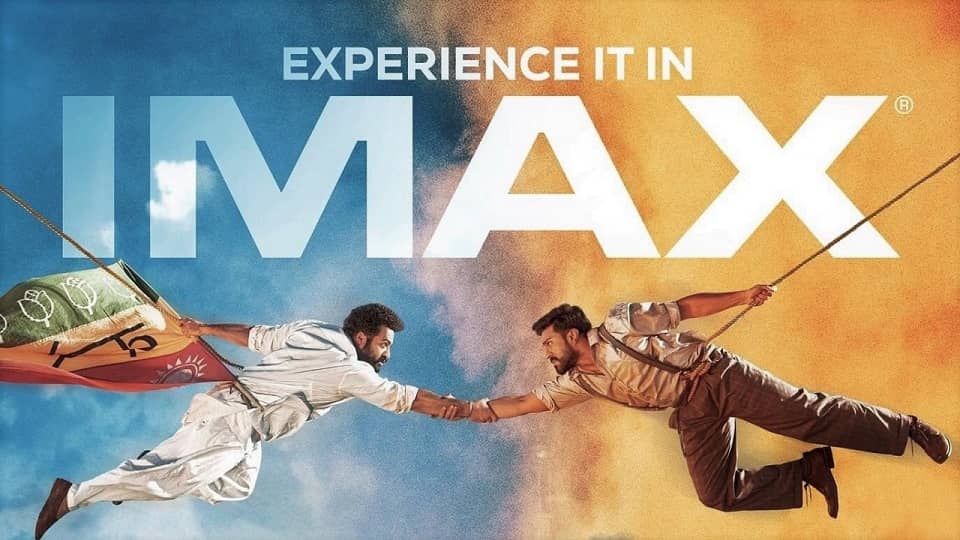
By the way, here’s the list of all Indian films made for the IMAX format.
Cinema chains also like this premium format because those tickets command 1.5-3x in pricing, and the audience is ready to pay it. You will notice whenever a big movie drops, IMAX auditoriums tend to fill faster when tickets go live.
IMAX is not just a big screen, it is a promise of scale, clarity and sound. It makes a film feel more cinematic in a way that a normal screen can’t.
Note that every IMAX screen isn’t simply owned outright by the exhibitor (e.g. PVR-INOX, Cinepolis, etc.)
The technology, branding, and even certain operational standards come under the license from the IMAX Corporation. Exhibitors pay for the rights to use the tech. Such a licensing arrangement ensures that the experience all around the world holds up to the standard.
How did IMAX start in India?
IMAX made its debut in India in 2001 at Wadala, Mumbai. It was Adlabs, which was a film processing company, that brought the IMAX Dome theatre to the country.
It was said to be the biggest IMAX theatre in the world at that time.
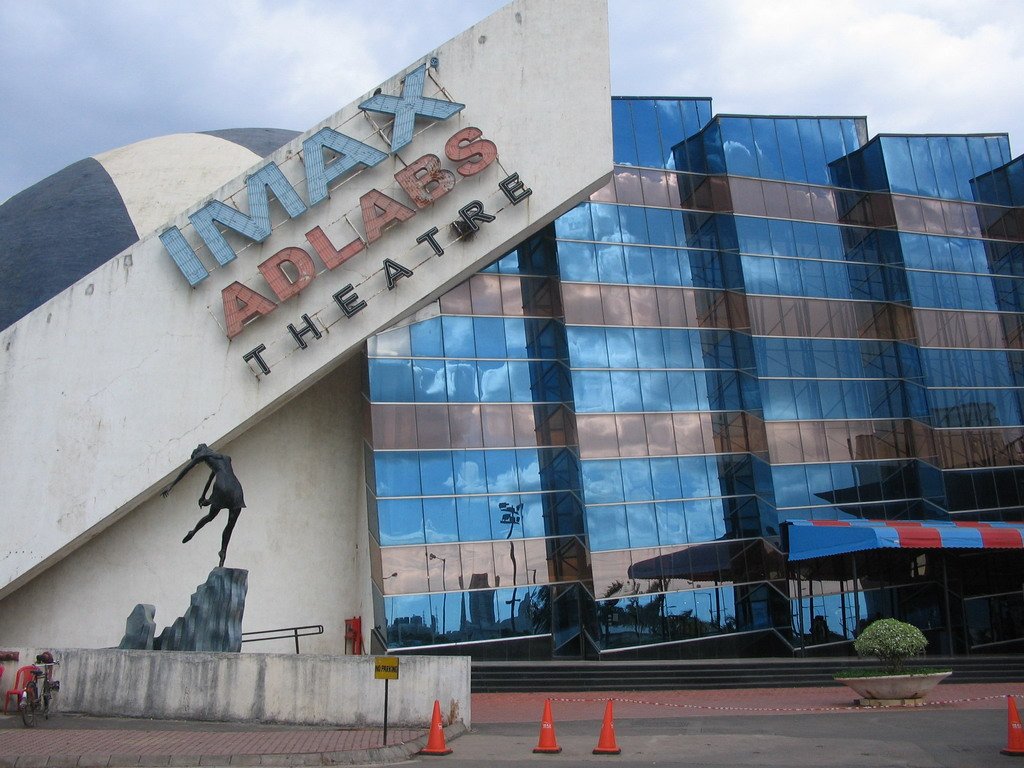
Then, just one year later, we got another one. Gujarat Science City opened the first IMAX 3D theatre in 2002.
But both of them were made for showing only exclusive nature and space documentaries.
After that, we got the Prasads IMAX at Hyderabad in 2003. It was also equipped with a 15/70mm projector, the best technology you can get in terms of film projection.
For audiences, this meant watching films exactly as the director intended, with spectacular image, immense depth, and rich sound.
There were two more IMAXs opened in the late 2000s, by a company called Aeren R: one in Ghaziabad (near Delhi) and the second in Kolkata.
In total, we had five 70mm IMAX theatres in India. Can you believe that! Now, we have only one, and that too doesn’t show commercial films. So, what happened?
In many ways, the technology was ahead of its time. Back then, very few hollywood films were actually shot in this large format. They were shot with standard cameras and got digitally remastered for IMAX. This process enhances the overall quality of both the image and the sound.
This changed with Christopher Nolan, when he shot some scenes of his movie The Dark Knight with the IMAX cameras.
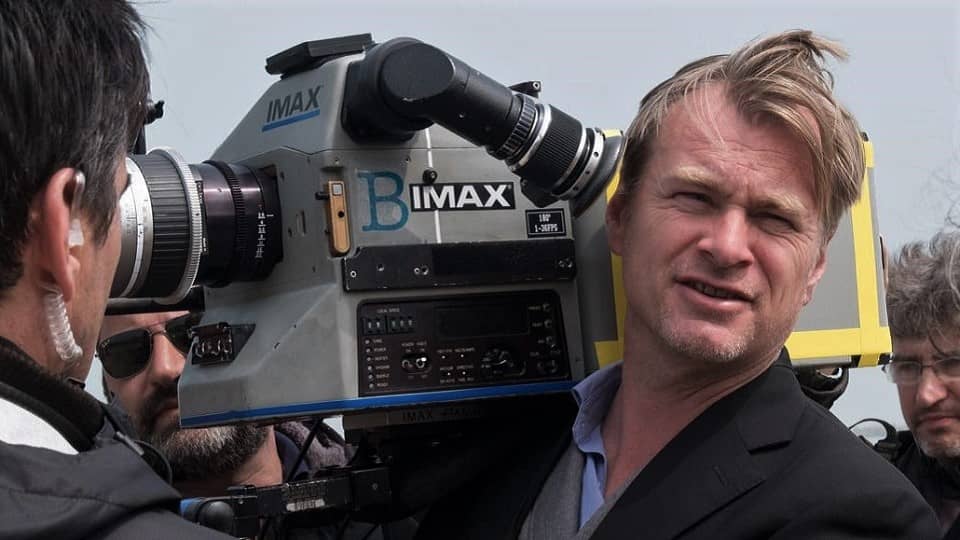
This wasn’t just a technical choice; it was a statement to demonstrate how new technology can enhance the world of storytelling. The movie inspired his peers to start experimenting with this new way to make films.
It was said to be the next big thing, but the technology had major complications. Their cameras were expensive, heavy, and required more maintenance. They required special handling and additional training by the crew, which adds to the production cost.
The world of filmmaking was not ready for it. These 70mm IMAX theatres rarely got any movies that were shot for this specific format.
On top of everything else, the process of bringing 70mm footage to the projection booth. Distributors had to go through the time-consuming task of transforming the film into physical 70mm prints.
Then, the theatre owner had to import the prints. This added a new cost to the already high expense of operating such a big screen.
Meanwhile, the world was moving toward digital cameras. IMAX also shifted to this trend, and we got newer but smaller “digital” alternatives. They are not near the clarity of 70mm cameras, but still offered a significant upgrade over regular screens.
Installations of these new digital IMAX screens by PVR began in Bengaluru, Mumbai, and Noida, starting in the 2010s.
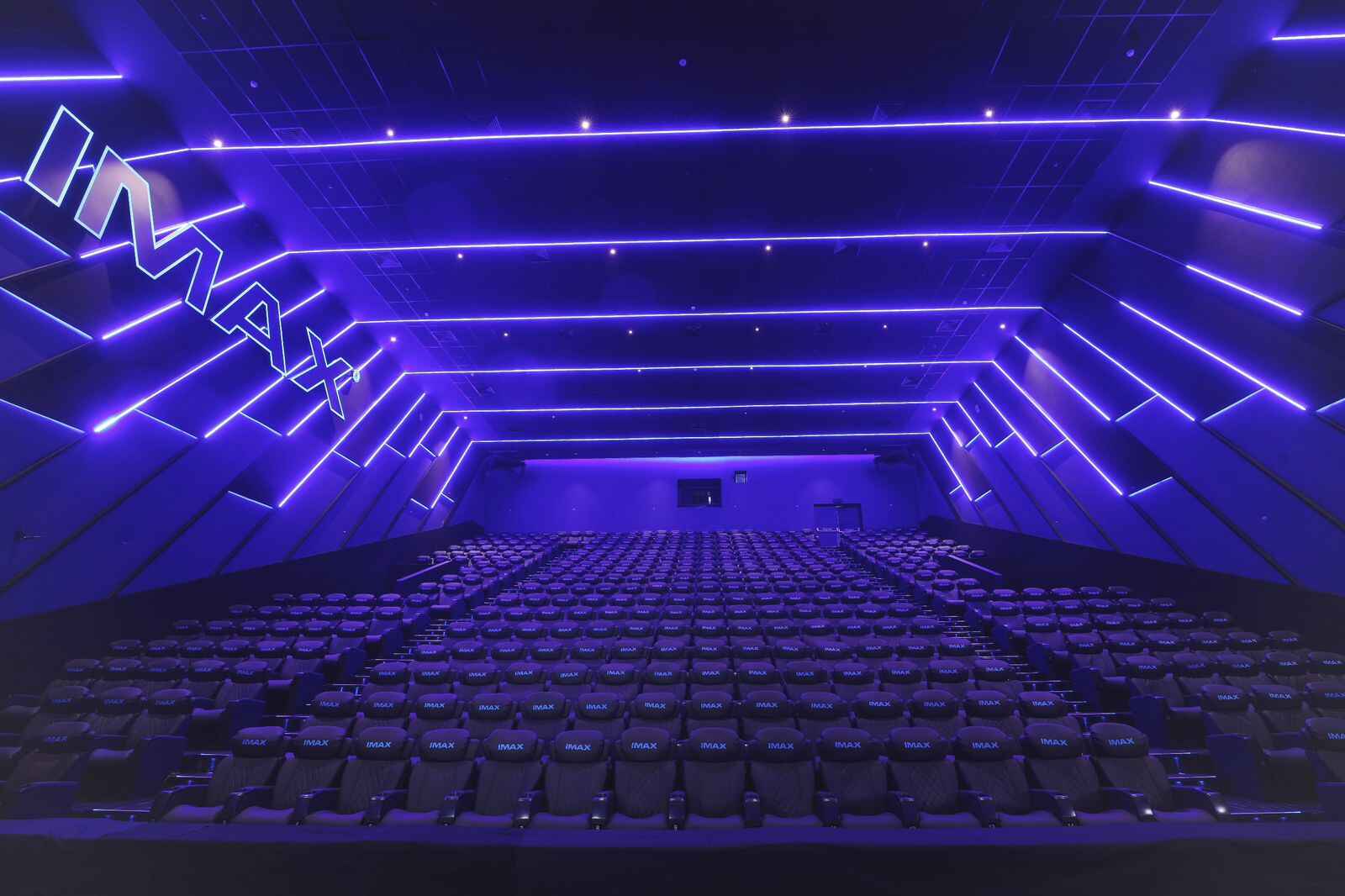
These screens were easy to set up, and easy to get the footage for the latest movies because everything was digitial.
What happened to 70mm IMAX in India?
Meanwhile, the 70mm IMAX theatres were struggling. The cost and logistics of getting physical prints were causing issues. Ultimately, tragedy hit everyone.
Both Aeren R screens got converted to normal screens. The Ghaziabad theatre was acquired by MovieMax who transformed it to a “MAXX” screen, while Kolkata’s screen got changed to PXL branding.
The Wadala IMAX switched to digital projectors.
Just as a side note, the Wadala multiplex still has its old IMAX projector. It was last used in 2018 for a special screening of Dunkirk in 70mm format. This was an exclusive event made especially for Christopher Nolan’s India visit.
Prasads was the only big hope! It was exhibiting commercial films from day one.
In November 2014, when Christopher Nolan’s Interstellar opened in theatres, Prasads was reportedly the only place in India where the space drama was watched on 70mm film.
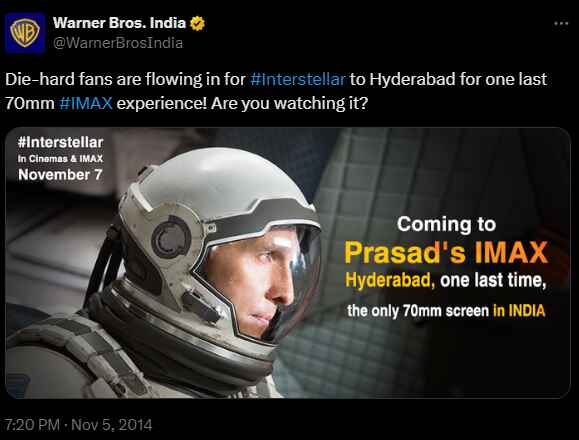
But it had to face the same challenges of not getting prints on time. That, combined with the government rule that capped ticket prices.
It was becoming impossible for Prasads to continue, so they had to get rid of their IMAX projector in 2014 and get something else. Still, Prasads has the biggest screen in India, about 101 feet wide.
Only 70mm IMAX working in India is located at Gujarat Science City, Ahmedabad. It has a large 1.43:1 aspect ratio and still showcases those nature and space documentaries. But no hollywood or Indian films.
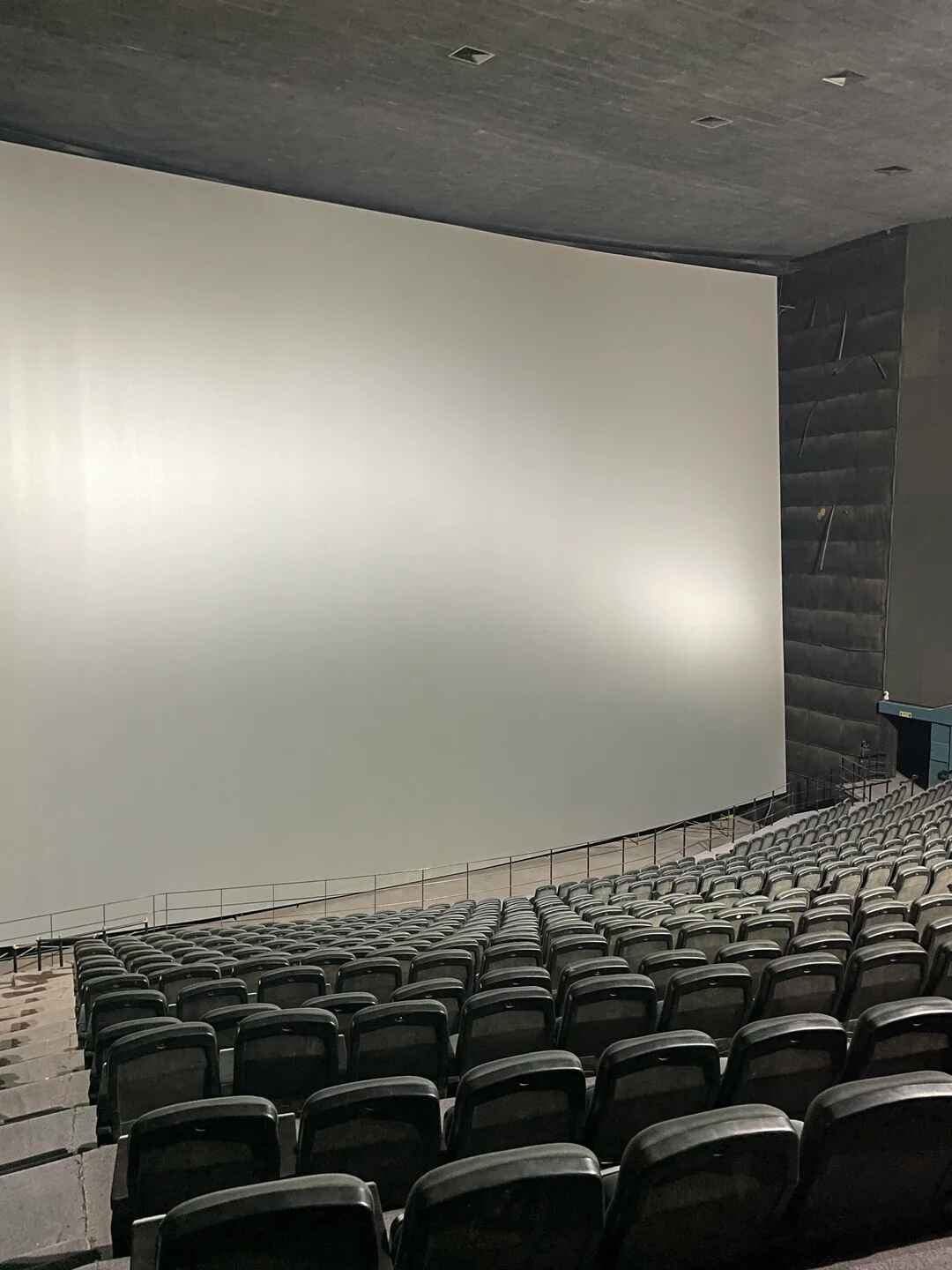
That’s why every commercial IMAX screen in India right now is a digital IMAX with the 1.90:1 aspect ratio.
Which is the Best IMAX Screen in India?
The best IMAX screen in India is at Mirah Cinema, Wadala, Mumbai. It has the biggest screen of all: 72×41 feet, equipped with Laser projectors.
However, deciding which is the best one is very subjective. Many factors include how well the screen is maintained and whether or not they are operating at peak quality, but just from the technical perspective, Miraj Wadala wins.
What I can say for sure is that what is best in Delhi is that’s where I live.
PVR Priya IMAX is by far the best IMAX in Delhi-NCR. It has a big screen: 69×36 feet, with laser projectors and a 12-channel audio system.
I watched F1 at PVR Priya, and it is my best movie experience ever (not saying it is the best movie ever). The seats are also comfortable, the prices are actually reasonable, and the theatre is within walking distance of the Vasant Vihar metro station.
In Bengaluru, you can decide between PVR Vega City and PVR VR. Both have similar screen sizes, but lack laser projectors and 12-channel audio.
In my experience, just from the technical view, go for one with the ‘Laser’ tag.
Here are all “IMAX with Laser” theatres in India:
- Miraj, Wadala, Mumbai
- INOX Skycity Oberoi Mall, Mumbai
- INOX Maison Jioworld, Mumbai
- EROS INOX, Mumbai
- PVR Phoenix Lower Parel, Mumbai
- INOX Phoenix Mall of Millennium, Pune
- PVR Priya, Delhi
- PVR Select Citywalk Delhi
- INOX Paras, Delhi
- INOX Vishal, Delhi
- PVR Superplex Mal of India, Noida
- PVR Phoenix Palladium, Ahmedabad
- Rajhans Precia Mall, Surat
- Broadway Cinemas, Coimbatore
- Cineopolis Centre Square Mall, Kochi
- PVR Nexus Mall, Bengaluru
- PVR Palazzo, Chennai
All these Laser theatres are 4K in resolution and provide better contrast and sharpness to the footage.
For a more detailed list, there is a sheet maintained by Kaustubh Debnath (aka KDCloudy), with exact dimensions of each IMAX screen in India.
Takeaways
Now you know everything to know about IMAX in India, where it started, how many cities have it, and what the future holds.
Personally, I love this premium format a lot. My first IMAX movie was Marvel’s Captain America: Civil War in 2016 at Logix, Noida. It had a whole scene (airport battle) in the expanded 1.90:1 aspect ratio. I was mesmerised not just by the full-screen experience, but the awesome video and audio quality.
After that, I have watched almost every big Marvel, DC, or Hollywood film on an IMAX screen, be it Avengers: Endgame, Dune or Oppenheimer.
And if you don’t know who I am? I am Ranish Chauhan a.k.a. Fulmino Fan, and I love Marvel & DC Superheroes and Sci-Fi movies. You can also check my YouTube channel.
If you have any questions, corrections, or any new updates for this blog, write me an email at fulminofan@gmail.com or hit me DM on Instagram.
